Organisation Behaviour Report: A David & Co Limited
VerifiedAdded on 2020/10/05
|16
|4678
|116
Report
AI Summary
This report provides a comprehensive analysis of organizational behaviour, focusing on how culture, politics, and power influence human behaviour within A David & Co Limited. It delves into motivation theories, including content and process theories like Maslow's Hierarchy and Herzberg's Two-Factor Theory, to explain how individuals can be motivated to achieve goals. The report also examines the characteristics of effective and ineffective teams, offering insights into team dynamics and the factors that contribute to team success. Furthermore, it applies organizational behaviour concepts and philosophies to the specific context of A David & Co Limited, illustrating how these principles can be used to address business situations and improve overall organizational performance. The report concludes by summarizing the key findings and emphasizing the importance of understanding organizational behaviour for effective management and leadership.
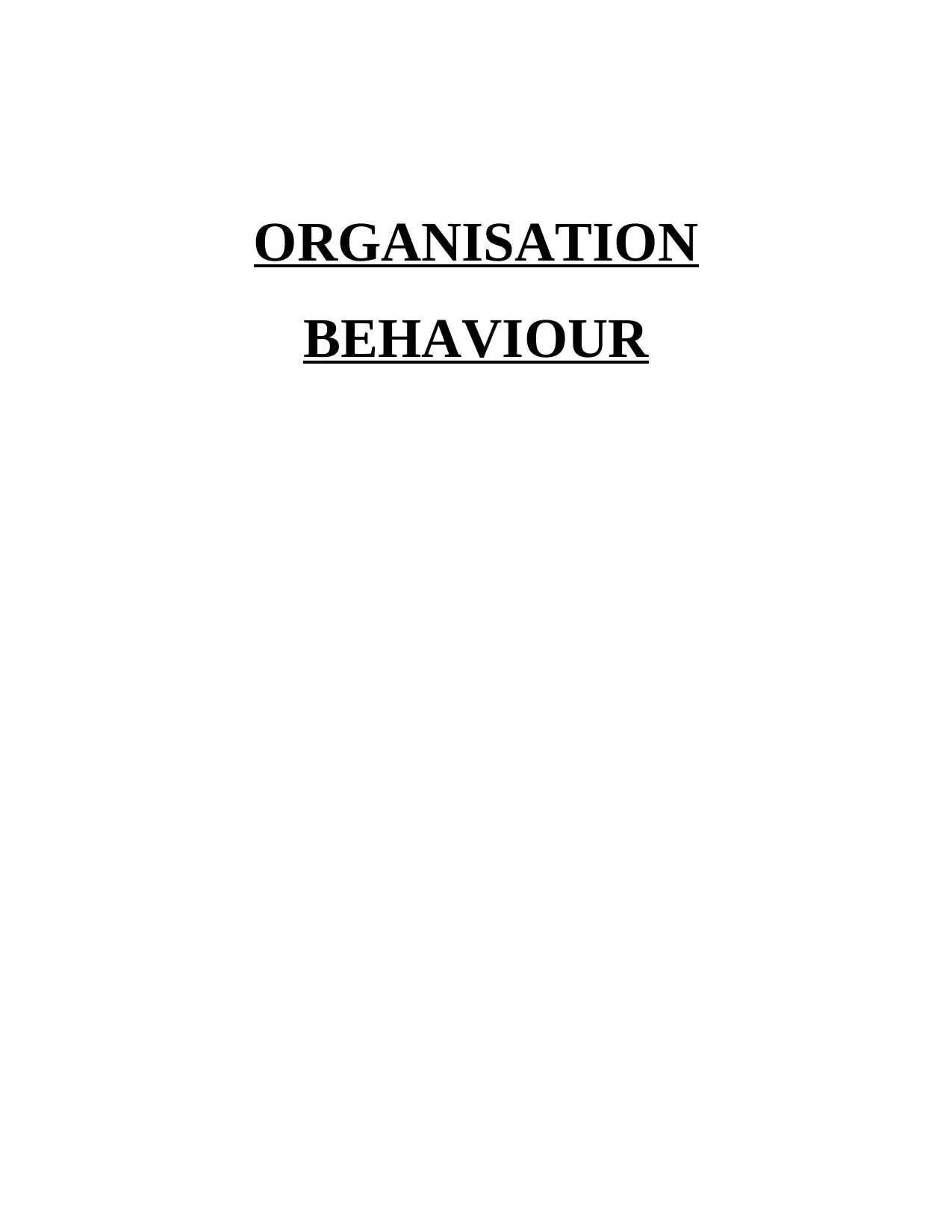
ORGANISATION
BEHAVIOUR
BEHAVIOUR
Paraphrase This Document
Need a fresh take? Get an instant paraphrase of this document with our AI Paraphraser
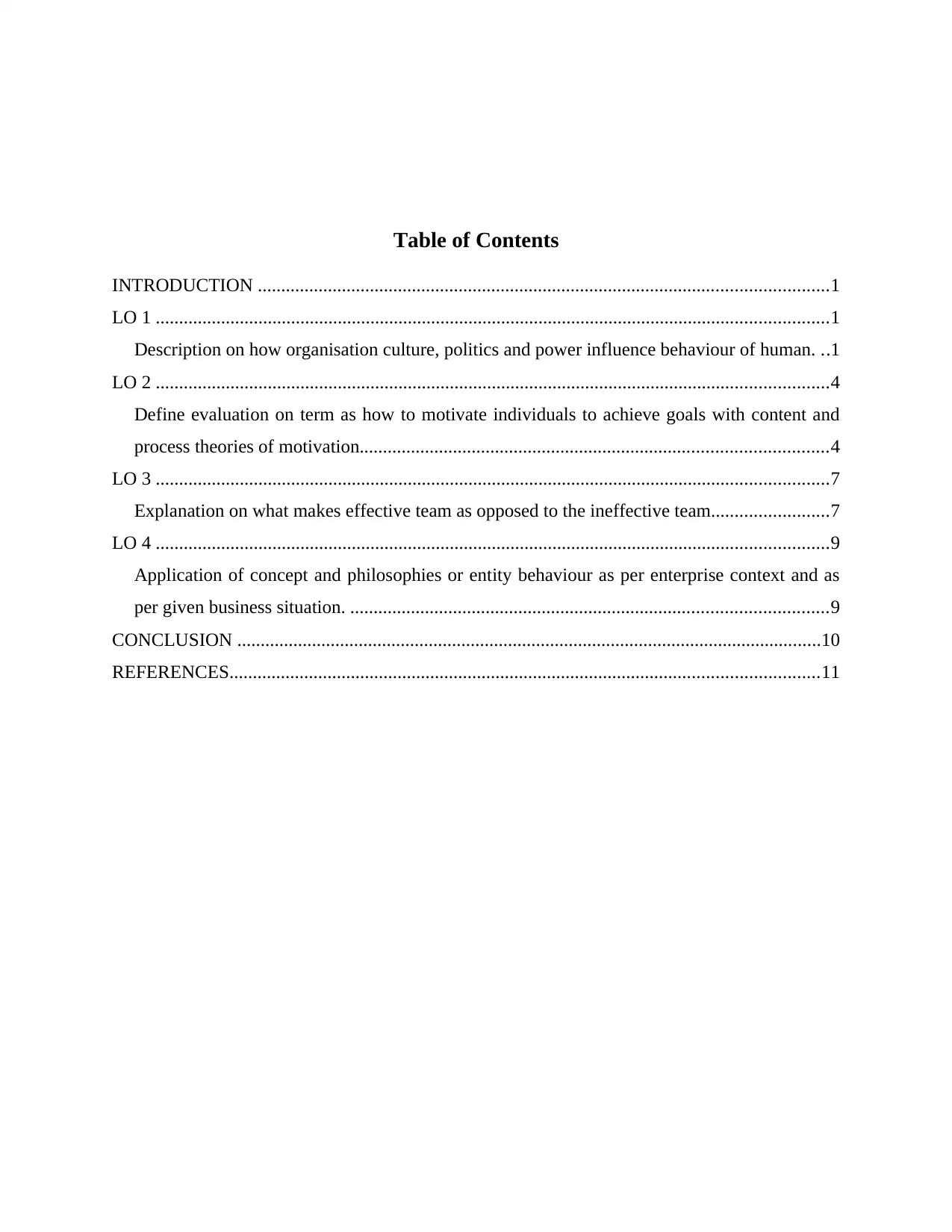
Table of Contents
INTRODUCTION ..........................................................................................................................1
LO 1 ................................................................................................................................................1
Description on how organisation culture, politics and power influence behaviour of human. ..1
LO 2 ................................................................................................................................................4
Define evaluation on term as how to motivate individuals to achieve goals with content and
process theories of motivation....................................................................................................4
LO 3 ................................................................................................................................................7
Explanation on what makes effective team as opposed to the ineffective team.........................7
LO 4 ................................................................................................................................................9
Application of concept and philosophies or entity behaviour as per enterprise context and as
per given business situation. ......................................................................................................9
CONCLUSION .............................................................................................................................10
REFERENCES..............................................................................................................................11
INTRODUCTION ..........................................................................................................................1
LO 1 ................................................................................................................................................1
Description on how organisation culture, politics and power influence behaviour of human. ..1
LO 2 ................................................................................................................................................4
Define evaluation on term as how to motivate individuals to achieve goals with content and
process theories of motivation....................................................................................................4
LO 3 ................................................................................................................................................7
Explanation on what makes effective team as opposed to the ineffective team.........................7
LO 4 ................................................................................................................................................9
Application of concept and philosophies or entity behaviour as per enterprise context and as
per given business situation. ......................................................................................................9
CONCLUSION .............................................................................................................................10
REFERENCES..............................................................................................................................11
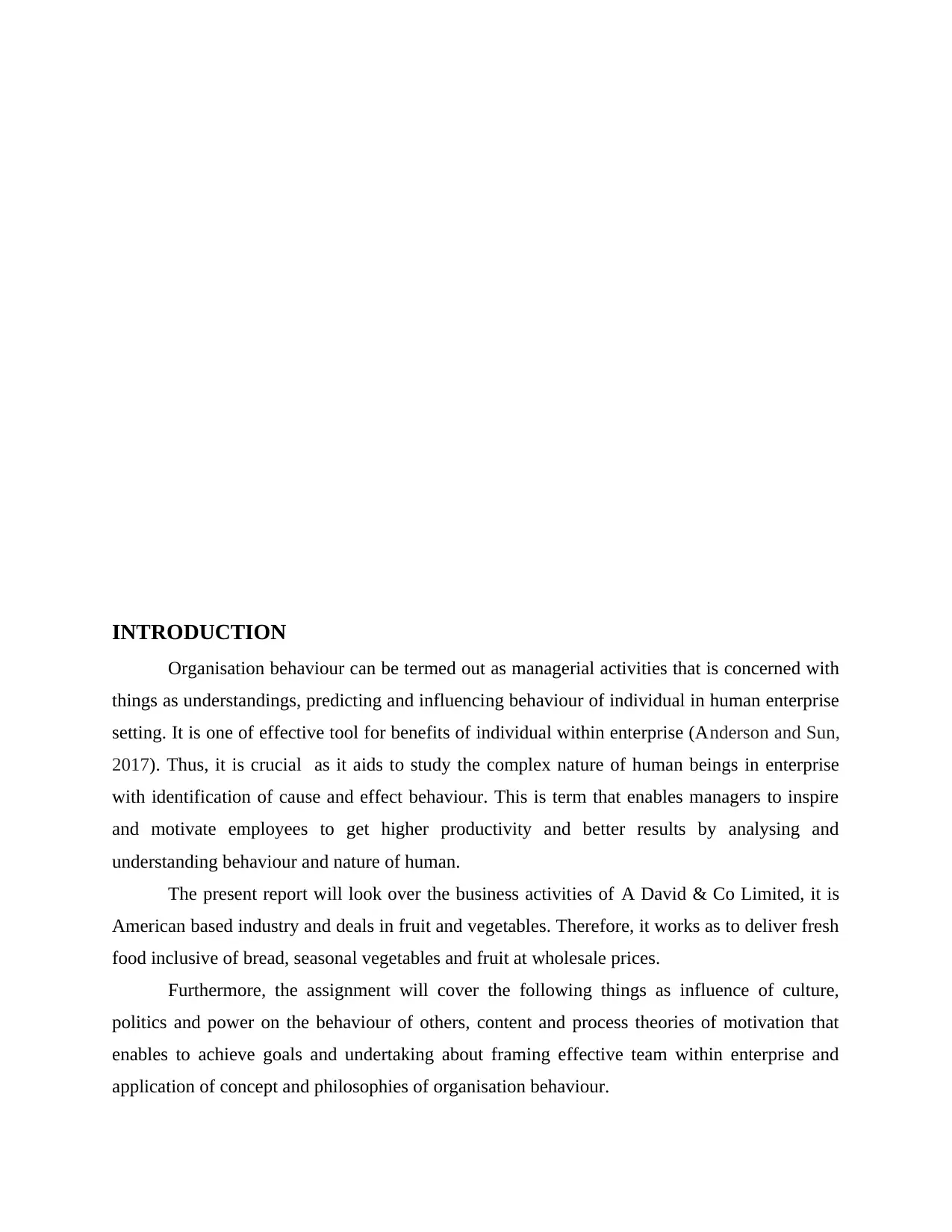
INTRODUCTION
Organisation behaviour can be termed out as managerial activities that is concerned with
things as understandings, predicting and influencing behaviour of individual in human enterprise
setting. It is one of effective tool for benefits of individual within enterprise (Anderson and Sun,
2017). Thus, it is crucial as it aids to study the complex nature of human beings in enterprise
with identification of cause and effect behaviour. This is term that enables managers to inspire
and motivate employees to get higher productivity and better results by analysing and
understanding behaviour and nature of human.
The present report will look over the business activities of A David & Co Limited, it is
American based industry and deals in fruit and vegetables. Therefore, it works as to deliver fresh
food inclusive of bread, seasonal vegetables and fruit at wholesale prices.
Furthermore, the assignment will cover the following things as influence of culture,
politics and power on the behaviour of others, content and process theories of motivation that
enables to achieve goals and undertaking about framing effective team within enterprise and
application of concept and philosophies of organisation behaviour.
Organisation behaviour can be termed out as managerial activities that is concerned with
things as understandings, predicting and influencing behaviour of individual in human enterprise
setting. It is one of effective tool for benefits of individual within enterprise (Anderson and Sun,
2017). Thus, it is crucial as it aids to study the complex nature of human beings in enterprise
with identification of cause and effect behaviour. This is term that enables managers to inspire
and motivate employees to get higher productivity and better results by analysing and
understanding behaviour and nature of human.
The present report will look over the business activities of A David & Co Limited, it is
American based industry and deals in fruit and vegetables. Therefore, it works as to deliver fresh
food inclusive of bread, seasonal vegetables and fruit at wholesale prices.
Furthermore, the assignment will cover the following things as influence of culture,
politics and power on the behaviour of others, content and process theories of motivation that
enables to achieve goals and undertaking about framing effective team within enterprise and
application of concept and philosophies of organisation behaviour.
⊘ This is a preview!⊘
Do you want full access?
Subscribe today to unlock all pages.

Trusted by 1+ million students worldwide
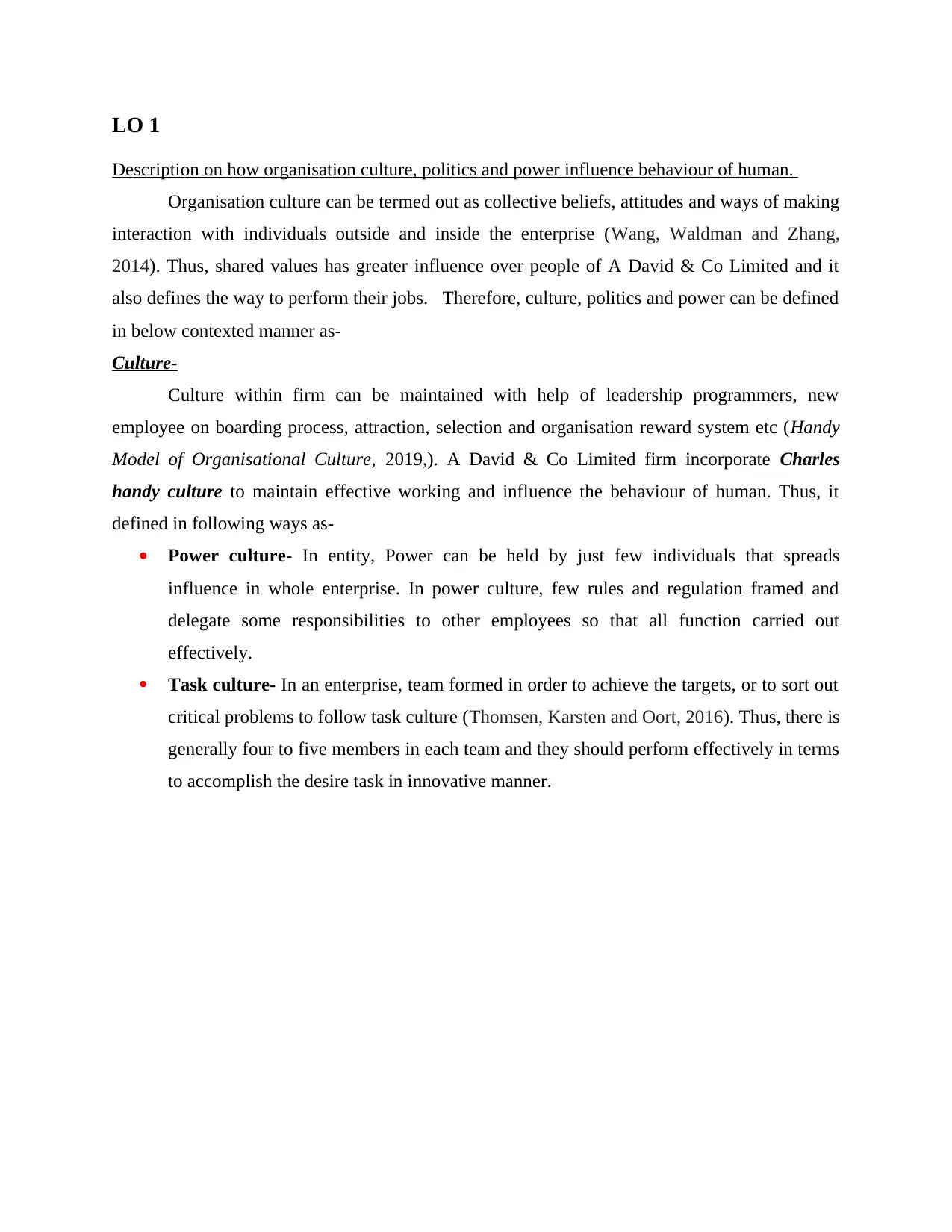
LO 1
Description on how organisation culture, politics and power influence behaviour of human.
Organisation culture can be termed out as collective beliefs, attitudes and ways of making
interaction with individuals outside and inside the enterprise (Wang, Waldman and Zhang,
2014). Thus, shared values has greater influence over people of A David & Co Limited and it
also defines the way to perform their jobs. Therefore, culture, politics and power can be defined
in below contexted manner as-
Culture-
Culture within firm can be maintained with help of leadership programmers, new
employee on boarding process, attraction, selection and organisation reward system etc (Handy
Model of Organisational Culture, 2019,). A David & Co Limited firm incorporate Charles
handy culture to maintain effective working and influence the behaviour of human. Thus, it
defined in following ways as-
Power culture- In entity, Power can be held by just few individuals that spreads
influence in whole enterprise. In power culture, few rules and regulation framed and
delegate some responsibilities to other employees so that all function carried out
effectively.
Task culture- In an enterprise, team formed in order to achieve the targets, or to sort out
critical problems to follow task culture (Thomsen, Karsten and Oort, 2016). Thus, there is
generally four to five members in each team and they should perform effectively in terms
to accomplish the desire task in innovative manner.
Description on how organisation culture, politics and power influence behaviour of human.
Organisation culture can be termed out as collective beliefs, attitudes and ways of making
interaction with individuals outside and inside the enterprise (Wang, Waldman and Zhang,
2014). Thus, shared values has greater influence over people of A David & Co Limited and it
also defines the way to perform their jobs. Therefore, culture, politics and power can be defined
in below contexted manner as-
Culture-
Culture within firm can be maintained with help of leadership programmers, new
employee on boarding process, attraction, selection and organisation reward system etc (Handy
Model of Organisational Culture, 2019,). A David & Co Limited firm incorporate Charles
handy culture to maintain effective working and influence the behaviour of human. Thus, it
defined in following ways as-
Power culture- In entity, Power can be held by just few individuals that spreads
influence in whole enterprise. In power culture, few rules and regulation framed and
delegate some responsibilities to other employees so that all function carried out
effectively.
Task culture- In an enterprise, team formed in order to achieve the targets, or to sort out
critical problems to follow task culture (Thomsen, Karsten and Oort, 2016). Thus, there is
generally four to five members in each team and they should perform effectively in terms
to accomplish the desire task in innovative manner.
Paraphrase This Document
Need a fresh take? Get an instant paraphrase of this document with our AI Paraphraser
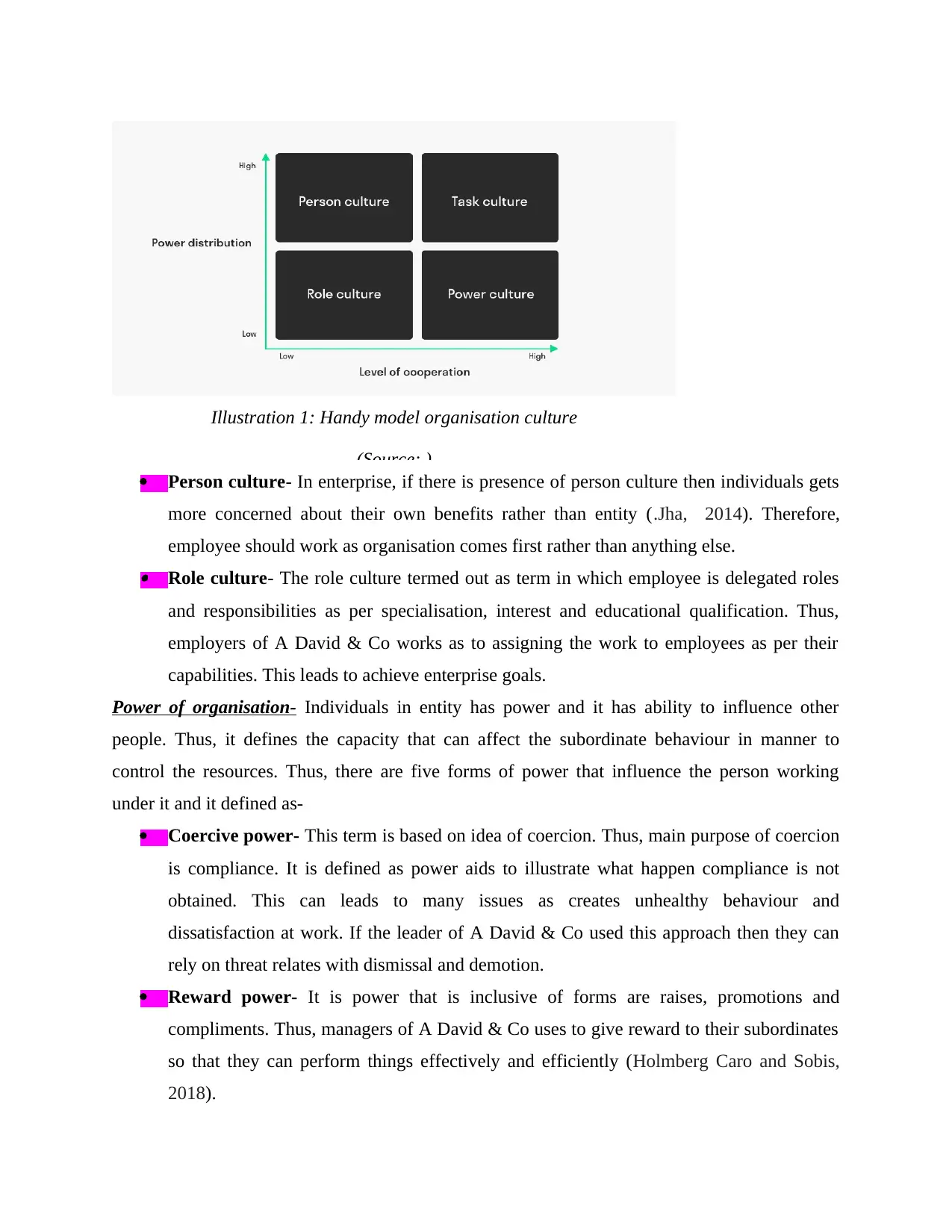
Illustration 1: Handy model organisation culture
(Source: )
Person culture- In enterprise, if there is presence of person culture then individuals gets
more concerned about their own benefits rather than entity (.Jha, 2014). Therefore,
employee should work as organisation comes first rather than anything else. Role culture- The role culture termed out as term in which employee is delegated roles
and responsibilities as per specialisation, interest and educational qualification. Thus,
employers of A David & Co works as to assigning the work to employees as per their
capabilities. This leads to achieve enterprise goals.
Power of organisation- Individuals in entity has power and it has ability to influence other
people. Thus, it defines the capacity that can affect the subordinate behaviour in manner to
control the resources. Thus, there are five forms of power that influence the person working
under it and it defined as-
Coercive power- This term is based on idea of coercion. Thus, main purpose of coercion
is compliance. It is defined as power aids to illustrate what happen compliance is not
obtained. This can leads to many issues as creates unhealthy behaviour and
dissatisfaction at work. If the leader of A David & Co used this approach then they can
rely on threat relates with dismissal and demotion.
Reward power- It is power that is inclusive of forms are raises, promotions and
compliments. Thus, managers of A David & Co uses to give reward to their subordinates
so that they can perform things effectively and efficiently (Holmberg Caro and Sobis,
2018).
(Source: )
Person culture- In enterprise, if there is presence of person culture then individuals gets
more concerned about their own benefits rather than entity (.Jha, 2014). Therefore,
employee should work as organisation comes first rather than anything else. Role culture- The role culture termed out as term in which employee is delegated roles
and responsibilities as per specialisation, interest and educational qualification. Thus,
employers of A David & Co works as to assigning the work to employees as per their
capabilities. This leads to achieve enterprise goals.
Power of organisation- Individuals in entity has power and it has ability to influence other
people. Thus, it defines the capacity that can affect the subordinate behaviour in manner to
control the resources. Thus, there are five forms of power that influence the person working
under it and it defined as-
Coercive power- This term is based on idea of coercion. Thus, main purpose of coercion
is compliance. It is defined as power aids to illustrate what happen compliance is not
obtained. This can leads to many issues as creates unhealthy behaviour and
dissatisfaction at work. If the leader of A David & Co used this approach then they can
rely on threat relates with dismissal and demotion.
Reward power- It is power that is inclusive of forms are raises, promotions and
compliments. Thus, managers of A David & Co uses to give reward to their subordinates
so that they can perform things effectively and efficiently (Holmberg Caro and Sobis,
2018).

Legitimate power- The term legitimate is based on role. The rewarding and punishing
employees can be seen as certain degree of reward and punishment (Kotni and Karumuri,
2018). It is based on role. In addition to it, this is crucial factor in dynamics of any
enterprise. Under this, power is derived with help of job, position, status etc.
Referent power- It is form of power which is based on management in terms to
administer the sense of approval. The leader with this power is a good appreciation in
business environment and also put major influence over others. Expert power- This relate as person is having in depth knowledge, information and
expertise. Under it, leaders in entity are intelligent and they have trust on their power in
order to full-fill the enterprise roles and responsibilities. It is ability that enables to
combine the power of reward in the right direction.
Politics in organisation- The workplace politics termed out as procedure and behave in human
interaction that is inclusive of power and authority. Thus, politics can be defined as informal
power, unofficial efforts to sell ideas and enhance power and achieve the targeted aims. The high
politics within enterprise affects the productivity and profitability. This leads to pay less attention
to work. Therefore, politics within the enterprise include various activities associated with use of
influences tactics and to take initiative to improvize the personal interest within enterprise.
Hereby, it can be stated that organisation culture, power and politics plays crucial role in
terms to influence and motivate the individuals so that they perform their best as to achieve the
desired goals. With use of it, A David & Co can be capable to build team and get desired results.
Hosfested cultural dimensions-
This is model that is composed of individualism-collectivism, uncertainty-avoidance
power distance and masculinity-femininity. It is developed by Greet Hostede. Thus, A David &
Co follows the below factors majorly as-
Power distance index- as per this, the level of distribution of power is not have been
evaluated in these dimension and it examines employees to feel about the culture
(Anderson and Sun, 2017). Thus, the quoted firm uses the democratic culture as there is
presence of low power.
Individualism vs collectivism- If in the enterprise each individuals think of self and take
efforts individually in order to achieve the set goals. With help of it, they cannot be able
employees can be seen as certain degree of reward and punishment (Kotni and Karumuri,
2018). It is based on role. In addition to it, this is crucial factor in dynamics of any
enterprise. Under this, power is derived with help of job, position, status etc.
Referent power- It is form of power which is based on management in terms to
administer the sense of approval. The leader with this power is a good appreciation in
business environment and also put major influence over others. Expert power- This relate as person is having in depth knowledge, information and
expertise. Under it, leaders in entity are intelligent and they have trust on their power in
order to full-fill the enterprise roles and responsibilities. It is ability that enables to
combine the power of reward in the right direction.
Politics in organisation- The workplace politics termed out as procedure and behave in human
interaction that is inclusive of power and authority. Thus, politics can be defined as informal
power, unofficial efforts to sell ideas and enhance power and achieve the targeted aims. The high
politics within enterprise affects the productivity and profitability. This leads to pay less attention
to work. Therefore, politics within the enterprise include various activities associated with use of
influences tactics and to take initiative to improvize the personal interest within enterprise.
Hereby, it can be stated that organisation culture, power and politics plays crucial role in
terms to influence and motivate the individuals so that they perform their best as to achieve the
desired goals. With use of it, A David & Co can be capable to build team and get desired results.
Hosfested cultural dimensions-
This is model that is composed of individualism-collectivism, uncertainty-avoidance
power distance and masculinity-femininity. It is developed by Greet Hostede. Thus, A David &
Co follows the below factors majorly as-
Power distance index- as per this, the level of distribution of power is not have been
evaluated in these dimension and it examines employees to feel about the culture
(Anderson and Sun, 2017). Thus, the quoted firm uses the democratic culture as there is
presence of low power.
Individualism vs collectivism- If in the enterprise each individuals think of self and take
efforts individually in order to achieve the set goals. With help of it, they cannot be able
⊘ This is a preview!⊘
Do you want full access?
Subscribe today to unlock all pages.

Trusted by 1+ million students worldwide

to achieve desired goals. Thus, they use collectivism in order to achieve the
organisational goals and objectives.
LO 2
P2 Define evaluation on term as how to motivate individuals to achieve goals with content and
process theories of motivation.
The term motivation can be defined as internal factors that aids to influence the ability
and employee performance in terms to achieve the enterprise goals. Thus, to motive employees
it is possible to meet the company goals (Wang, Waldman and Zhang, 2014). Therefore, it is
supportive function that improvise the confidence and self esteem that gives strength in order to
get the desired goals. Thus, motivation is term that is defined in two terms as-
Intrinsic motivators- It is term that come from the actual performance of task. Thus, it is
inclusive of things as achievement, responsibilities and competence etc.
Extrinsic motivators- It is inclusive of motivation factors that is consisted with pay,
feedback, promotion, working conditions and this are things that can be controlled by
others.
Motivation techniques- Enhancement in motivation at the workplace can improve performance,
raise morale and boost productivity. Therefore, this is defined in following manner as-
The creation of positive work environment leads to encourage team and employees
performs each thing in better and effective mode.
To enhance the motivational level of employees within providing incentive.
To motivate the employees, the firm as A David & Co uses content and process theories
of motivation so that they encourage workers to perform their best. Thus, its defined in below
defined manner as-
CONTENT THEORIES
Maslow's hierarchy theory- It is crucial in terms to motivating the behaviour of
individual. Thus, it is composed of physiological, security, social and self esteem. Therefore, it
defined as five stage model that has division into deficiency and growth needs. To fulfil this
lower need of employees is crucial in terms to avoid unpleasant feeling or consequences. Thus, it
defined as-
organisational goals and objectives.
LO 2
P2 Define evaluation on term as how to motivate individuals to achieve goals with content and
process theories of motivation.
The term motivation can be defined as internal factors that aids to influence the ability
and employee performance in terms to achieve the enterprise goals. Thus, to motive employees
it is possible to meet the company goals (Wang, Waldman and Zhang, 2014). Therefore, it is
supportive function that improvise the confidence and self esteem that gives strength in order to
get the desired goals. Thus, motivation is term that is defined in two terms as-
Intrinsic motivators- It is term that come from the actual performance of task. Thus, it is
inclusive of things as achievement, responsibilities and competence etc.
Extrinsic motivators- It is inclusive of motivation factors that is consisted with pay,
feedback, promotion, working conditions and this are things that can be controlled by
others.
Motivation techniques- Enhancement in motivation at the workplace can improve performance,
raise morale and boost productivity. Therefore, this is defined in following manner as-
The creation of positive work environment leads to encourage team and employees
performs each thing in better and effective mode.
To enhance the motivational level of employees within providing incentive.
To motivate the employees, the firm as A David & Co uses content and process theories
of motivation so that they encourage workers to perform their best. Thus, its defined in below
defined manner as-
CONTENT THEORIES
Maslow's hierarchy theory- It is crucial in terms to motivating the behaviour of
individual. Thus, it is composed of physiological, security, social and self esteem. Therefore, it
defined as five stage model that has division into deficiency and growth needs. To fulfil this
lower need of employees is crucial in terms to avoid unpleasant feeling or consequences. Thus, it
defined as-
Paraphrase This Document
Need a fresh take? Get an instant paraphrase of this document with our AI Paraphraser
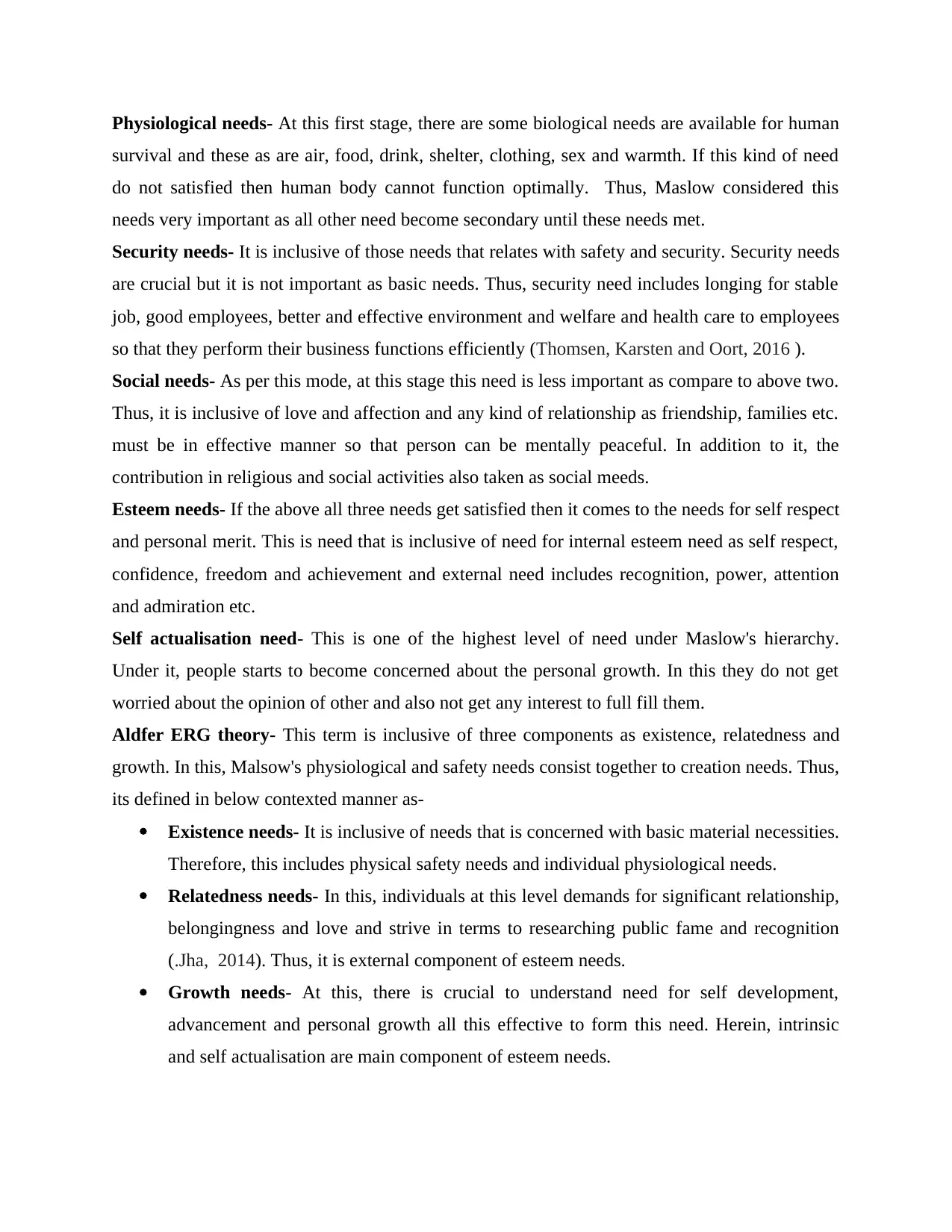
Physiological needs- At this first stage, there are some biological needs are available for human
survival and these as are air, food, drink, shelter, clothing, sex and warmth. If this kind of need
do not satisfied then human body cannot function optimally. Thus, Maslow considered this
needs very important as all other need become secondary until these needs met.
Security needs- It is inclusive of those needs that relates with safety and security. Security needs
are crucial but it is not important as basic needs. Thus, security need includes longing for stable
job, good employees, better and effective environment and welfare and health care to employees
so that they perform their business functions efficiently (Thomsen, Karsten and Oort, 2016 ).
Social needs- As per this mode, at this stage this need is less important as compare to above two.
Thus, it is inclusive of love and affection and any kind of relationship as friendship, families etc.
must be in effective manner so that person can be mentally peaceful. In addition to it, the
contribution in religious and social activities also taken as social meeds.
Esteem needs- If the above all three needs get satisfied then it comes to the needs for self respect
and personal merit. This is need that is inclusive of need for internal esteem need as self respect,
confidence, freedom and achievement and external need includes recognition, power, attention
and admiration etc.
Self actualisation need- This is one of the highest level of need under Maslow's hierarchy.
Under it, people starts to become concerned about the personal growth. In this they do not get
worried about the opinion of other and also not get any interest to full fill them.
Aldfer ERG theory- This term is inclusive of three components as existence, relatedness and
growth. In this, Malsow's physiological and safety needs consist together to creation needs. Thus,
its defined in below contexted manner as-
Existence needs- It is inclusive of needs that is concerned with basic material necessities.
Therefore, this includes physical safety needs and individual physiological needs.
Relatedness needs- In this, individuals at this level demands for significant relationship,
belongingness and love and strive in terms to researching public fame and recognition
(.Jha, 2014). Thus, it is external component of esteem needs.
Growth needs- At this, there is crucial to understand need for self development,
advancement and personal growth all this effective to form this need. Herein, intrinsic
and self actualisation are main component of esteem needs.
survival and these as are air, food, drink, shelter, clothing, sex and warmth. If this kind of need
do not satisfied then human body cannot function optimally. Thus, Maslow considered this
needs very important as all other need become secondary until these needs met.
Security needs- It is inclusive of those needs that relates with safety and security. Security needs
are crucial but it is not important as basic needs. Thus, security need includes longing for stable
job, good employees, better and effective environment and welfare and health care to employees
so that they perform their business functions efficiently (Thomsen, Karsten and Oort, 2016 ).
Social needs- As per this mode, at this stage this need is less important as compare to above two.
Thus, it is inclusive of love and affection and any kind of relationship as friendship, families etc.
must be in effective manner so that person can be mentally peaceful. In addition to it, the
contribution in religious and social activities also taken as social meeds.
Esteem needs- If the above all three needs get satisfied then it comes to the needs for self respect
and personal merit. This is need that is inclusive of need for internal esteem need as self respect,
confidence, freedom and achievement and external need includes recognition, power, attention
and admiration etc.
Self actualisation need- This is one of the highest level of need under Maslow's hierarchy.
Under it, people starts to become concerned about the personal growth. In this they do not get
worried about the opinion of other and also not get any interest to full fill them.
Aldfer ERG theory- This term is inclusive of three components as existence, relatedness and
growth. In this, Malsow's physiological and safety needs consist together to creation needs. Thus,
its defined in below contexted manner as-
Existence needs- It is inclusive of needs that is concerned with basic material necessities.
Therefore, this includes physical safety needs and individual physiological needs.
Relatedness needs- In this, individuals at this level demands for significant relationship,
belongingness and love and strive in terms to researching public fame and recognition
(.Jha, 2014). Thus, it is external component of esteem needs.
Growth needs- At this, there is crucial to understand need for self development,
advancement and personal growth all this effective to form this need. Herein, intrinsic
and self actualisation are main component of esteem needs.
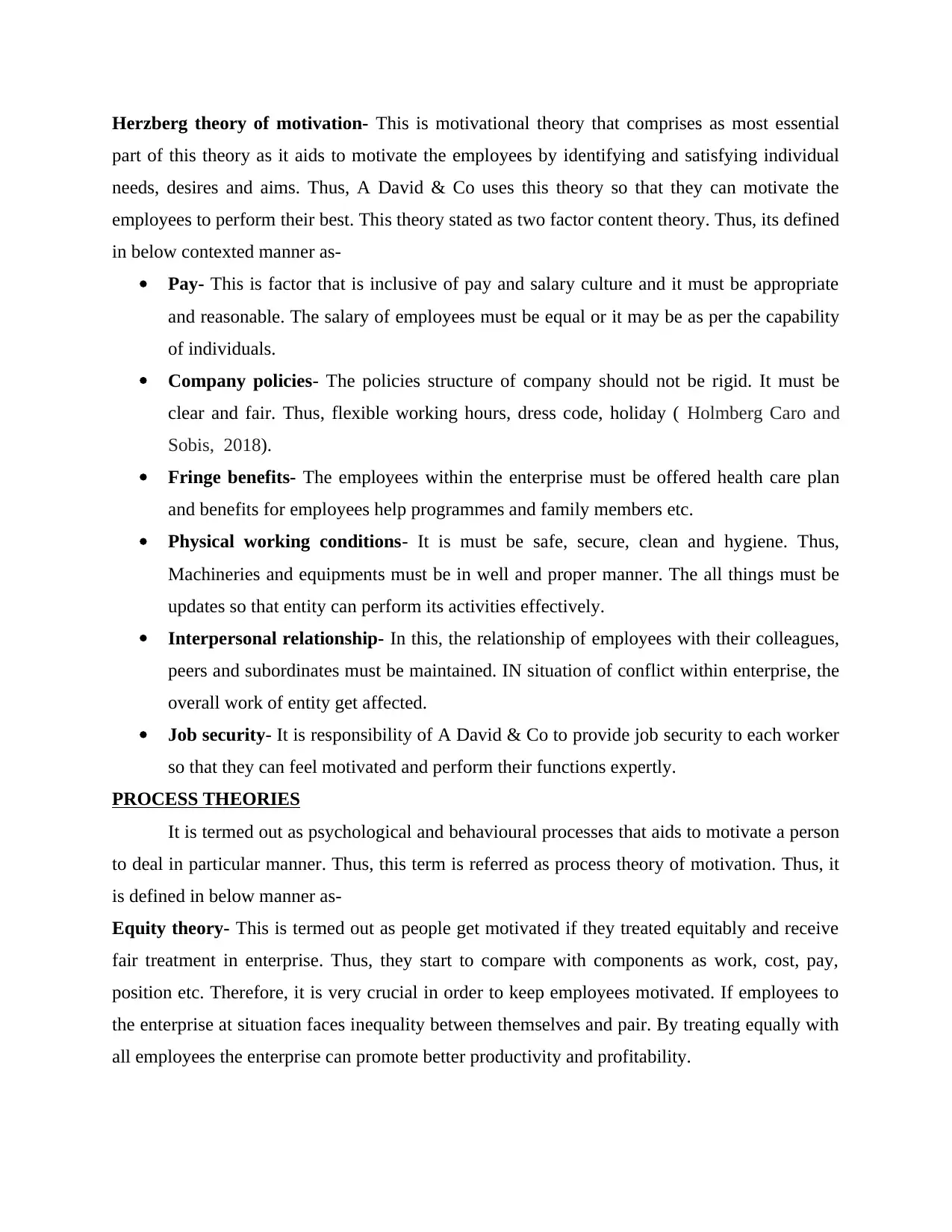
Herzberg theory of motivation- This is motivational theory that comprises as most essential
part of this theory as it aids to motivate the employees by identifying and satisfying individual
needs, desires and aims. Thus, A David & Co uses this theory so that they can motivate the
employees to perform their best. This theory stated as two factor content theory. Thus, its defined
in below contexted manner as-
Pay- This is factor that is inclusive of pay and salary culture and it must be appropriate
and reasonable. The salary of employees must be equal or it may be as per the capability
of individuals.
Company policies- The policies structure of company should not be rigid. It must be
clear and fair. Thus, flexible working hours, dress code, holiday ( Holmberg Caro and
Sobis, 2018).
Fringe benefits- The employees within the enterprise must be offered health care plan
and benefits for employees help programmes and family members etc.
Physical working conditions- It is must be safe, secure, clean and hygiene. Thus,
Machineries and equipments must be in well and proper manner. The all things must be
updates so that entity can perform its activities effectively.
Interpersonal relationship- In this, the relationship of employees with their colleagues,
peers and subordinates must be maintained. IN situation of conflict within enterprise, the
overall work of entity get affected.
Job security- It is responsibility of A David & Co to provide job security to each worker
so that they can feel motivated and perform their functions expertly.
PROCESS THEORIES
It is termed out as psychological and behavioural processes that aids to motivate a person
to deal in particular manner. Thus, this term is referred as process theory of motivation. Thus, it
is defined in below manner as-
Equity theory- This is termed out as people get motivated if they treated equitably and receive
fair treatment in enterprise. Thus, they start to compare with components as work, cost, pay,
position etc. Therefore, it is very crucial in order to keep employees motivated. If employees to
the enterprise at situation faces inequality between themselves and pair. By treating equally with
all employees the enterprise can promote better productivity and profitability.
part of this theory as it aids to motivate the employees by identifying and satisfying individual
needs, desires and aims. Thus, A David & Co uses this theory so that they can motivate the
employees to perform their best. This theory stated as two factor content theory. Thus, its defined
in below contexted manner as-
Pay- This is factor that is inclusive of pay and salary culture and it must be appropriate
and reasonable. The salary of employees must be equal or it may be as per the capability
of individuals.
Company policies- The policies structure of company should not be rigid. It must be
clear and fair. Thus, flexible working hours, dress code, holiday ( Holmberg Caro and
Sobis, 2018).
Fringe benefits- The employees within the enterprise must be offered health care plan
and benefits for employees help programmes and family members etc.
Physical working conditions- It is must be safe, secure, clean and hygiene. Thus,
Machineries and equipments must be in well and proper manner. The all things must be
updates so that entity can perform its activities effectively.
Interpersonal relationship- In this, the relationship of employees with their colleagues,
peers and subordinates must be maintained. IN situation of conflict within enterprise, the
overall work of entity get affected.
Job security- It is responsibility of A David & Co to provide job security to each worker
so that they can feel motivated and perform their functions expertly.
PROCESS THEORIES
It is termed out as psychological and behavioural processes that aids to motivate a person
to deal in particular manner. Thus, this term is referred as process theory of motivation. Thus, it
is defined in below manner as-
Equity theory- This is termed out as people get motivated if they treated equitably and receive
fair treatment in enterprise. Thus, they start to compare with components as work, cost, pay,
position etc. Therefore, it is very crucial in order to keep employees motivated. If employees to
the enterprise at situation faces inequality between themselves and pair. By treating equally with
all employees the enterprise can promote better productivity and profitability.
⊘ This is a preview!⊘
Do you want full access?
Subscribe today to unlock all pages.

Trusted by 1+ million students worldwide
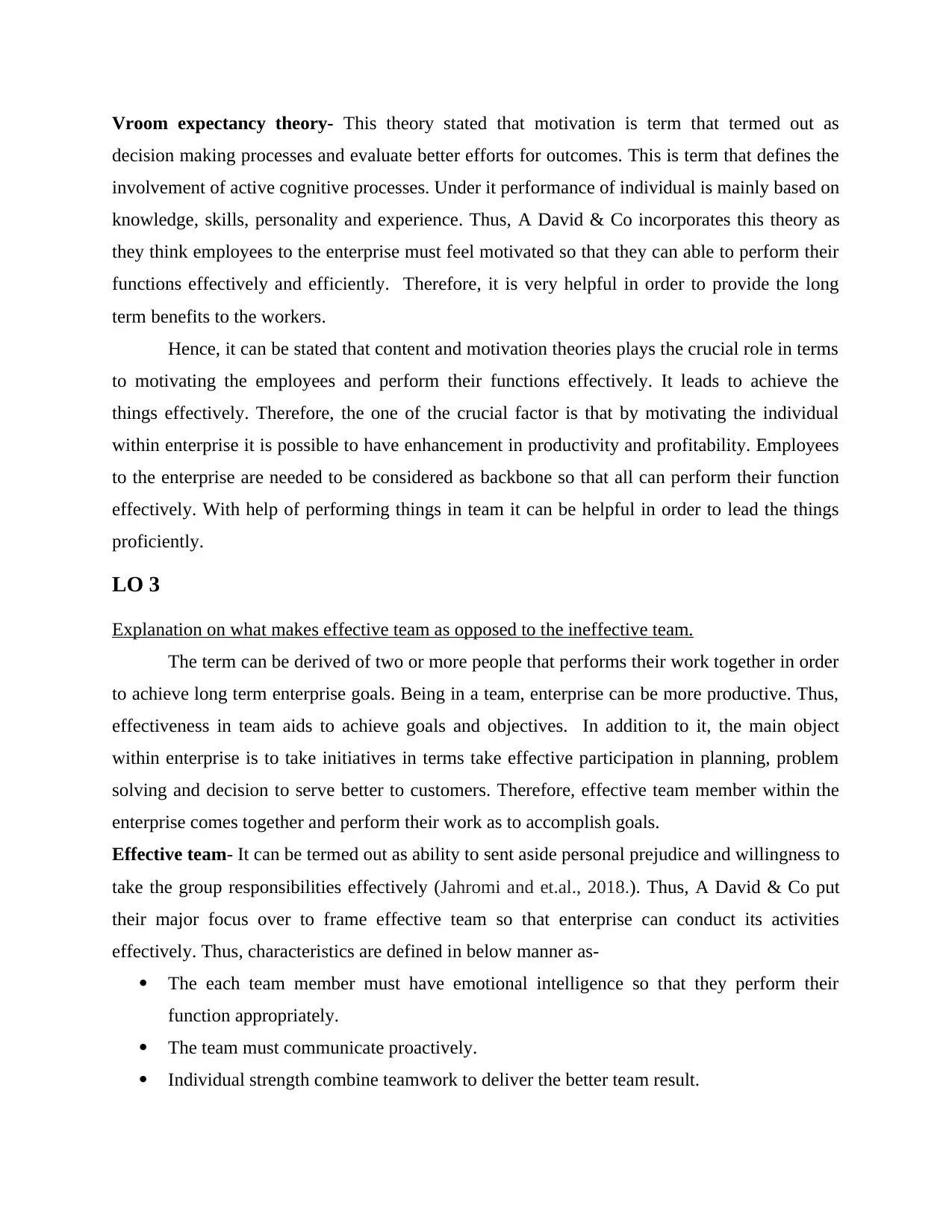
Vroom expectancy theory- This theory stated that motivation is term that termed out as
decision making processes and evaluate better efforts for outcomes. This is term that defines the
involvement of active cognitive processes. Under it performance of individual is mainly based on
knowledge, skills, personality and experience. Thus, A David & Co incorporates this theory as
they think employees to the enterprise must feel motivated so that they can able to perform their
functions effectively and efficiently. Therefore, it is very helpful in order to provide the long
term benefits to the workers.
Hence, it can be stated that content and motivation theories plays the crucial role in terms
to motivating the employees and perform their functions effectively. It leads to achieve the
things effectively. Therefore, the one of the crucial factor is that by motivating the individual
within enterprise it is possible to have enhancement in productivity and profitability. Employees
to the enterprise are needed to be considered as backbone so that all can perform their function
effectively. With help of performing things in team it can be helpful in order to lead the things
proficiently.
LO 3
Explanation on what makes effective team as opposed to the ineffective team.
The term can be derived of two or more people that performs their work together in order
to achieve long term enterprise goals. Being in a team, enterprise can be more productive. Thus,
effectiveness in team aids to achieve goals and objectives. In addition to it, the main object
within enterprise is to take initiatives in terms take effective participation in planning, problem
solving and decision to serve better to customers. Therefore, effective team member within the
enterprise comes together and perform their work as to accomplish goals.
Effective team- It can be termed out as ability to sent aside personal prejudice and willingness to
take the group responsibilities effectively (Jahromi and et.al., 2018.). Thus, A David & Co put
their major focus over to frame effective team so that enterprise can conduct its activities
effectively. Thus, characteristics are defined in below manner as-
The each team member must have emotional intelligence so that they perform their
function appropriately.
The team must communicate proactively.
Individual strength combine teamwork to deliver the better team result.
decision making processes and evaluate better efforts for outcomes. This is term that defines the
involvement of active cognitive processes. Under it performance of individual is mainly based on
knowledge, skills, personality and experience. Thus, A David & Co incorporates this theory as
they think employees to the enterprise must feel motivated so that they can able to perform their
functions effectively and efficiently. Therefore, it is very helpful in order to provide the long
term benefits to the workers.
Hence, it can be stated that content and motivation theories plays the crucial role in terms
to motivating the employees and perform their functions effectively. It leads to achieve the
things effectively. Therefore, the one of the crucial factor is that by motivating the individual
within enterprise it is possible to have enhancement in productivity and profitability. Employees
to the enterprise are needed to be considered as backbone so that all can perform their function
effectively. With help of performing things in team it can be helpful in order to lead the things
proficiently.
LO 3
Explanation on what makes effective team as opposed to the ineffective team.
The term can be derived of two or more people that performs their work together in order
to achieve long term enterprise goals. Being in a team, enterprise can be more productive. Thus,
effectiveness in team aids to achieve goals and objectives. In addition to it, the main object
within enterprise is to take initiatives in terms take effective participation in planning, problem
solving and decision to serve better to customers. Therefore, effective team member within the
enterprise comes together and perform their work as to accomplish goals.
Effective team- It can be termed out as ability to sent aside personal prejudice and willingness to
take the group responsibilities effectively (Jahromi and et.al., 2018.). Thus, A David & Co put
their major focus over to frame effective team so that enterprise can conduct its activities
effectively. Thus, characteristics are defined in below manner as-
The each team member must have emotional intelligence so that they perform their
function appropriately.
The team must communicate proactively.
Individual strength combine teamwork to deliver the better team result.
Paraphrase This Document
Need a fresh take? Get an instant paraphrase of this document with our AI Paraphraser

The team member must have the capacity to deal with each task in proficient mode.
Team member must have good communication skill.
Ineffective team- There are five factors that can lead to ineffective performance within team.
Thus, it is inclusive of lack of focus, inequality of group members, negativity and poor
leadership.
Ineffectiveness in team leads to may suffer and results in decrease in effectiveness of
team.
The ineffective team leads to create disorganisation.
Ineffective team do not monitor the process so it leads to create unproductive results.
Errors and negativity.
Lack of cohesion etc.
Thus, A David & Co using team development model with help of Tuckman's stages of
group development as-
This is model that is helpful in terms to develop the maturity, relationship establish, leader
changes leadership style and ability. Thus, it is inclusive in following manner as-
Forming- High dependence on leader aids to guide and direct employees so that altogether can
achieve common goal (Tuckman’s Team & Group Development Model, 2019). Thus, roles and
responsibilities of leaders are unclear. It is the initial stage of team growth and leader needs to
frame team that aids conduct the work with proper direction. Team member ensures that with
help of determining the team responsibilities the all things can be carried in better mode.
Team member must have good communication skill.
Ineffective team- There are five factors that can lead to ineffective performance within team.
Thus, it is inclusive of lack of focus, inequality of group members, negativity and poor
leadership.
Ineffectiveness in team leads to may suffer and results in decrease in effectiveness of
team.
The ineffective team leads to create disorganisation.
Ineffective team do not monitor the process so it leads to create unproductive results.
Errors and negativity.
Lack of cohesion etc.
Thus, A David & Co using team development model with help of Tuckman's stages of
group development as-
This is model that is helpful in terms to develop the maturity, relationship establish, leader
changes leadership style and ability. Thus, it is inclusive in following manner as-
Forming- High dependence on leader aids to guide and direct employees so that altogether can
achieve common goal (Tuckman’s Team & Group Development Model, 2019). Thus, roles and
responsibilities of leaders are unclear. It is the initial stage of team growth and leader needs to
frame team that aids conduct the work with proper direction. Team member ensures that with
help of determining the team responsibilities the all things can be carried in better mode.
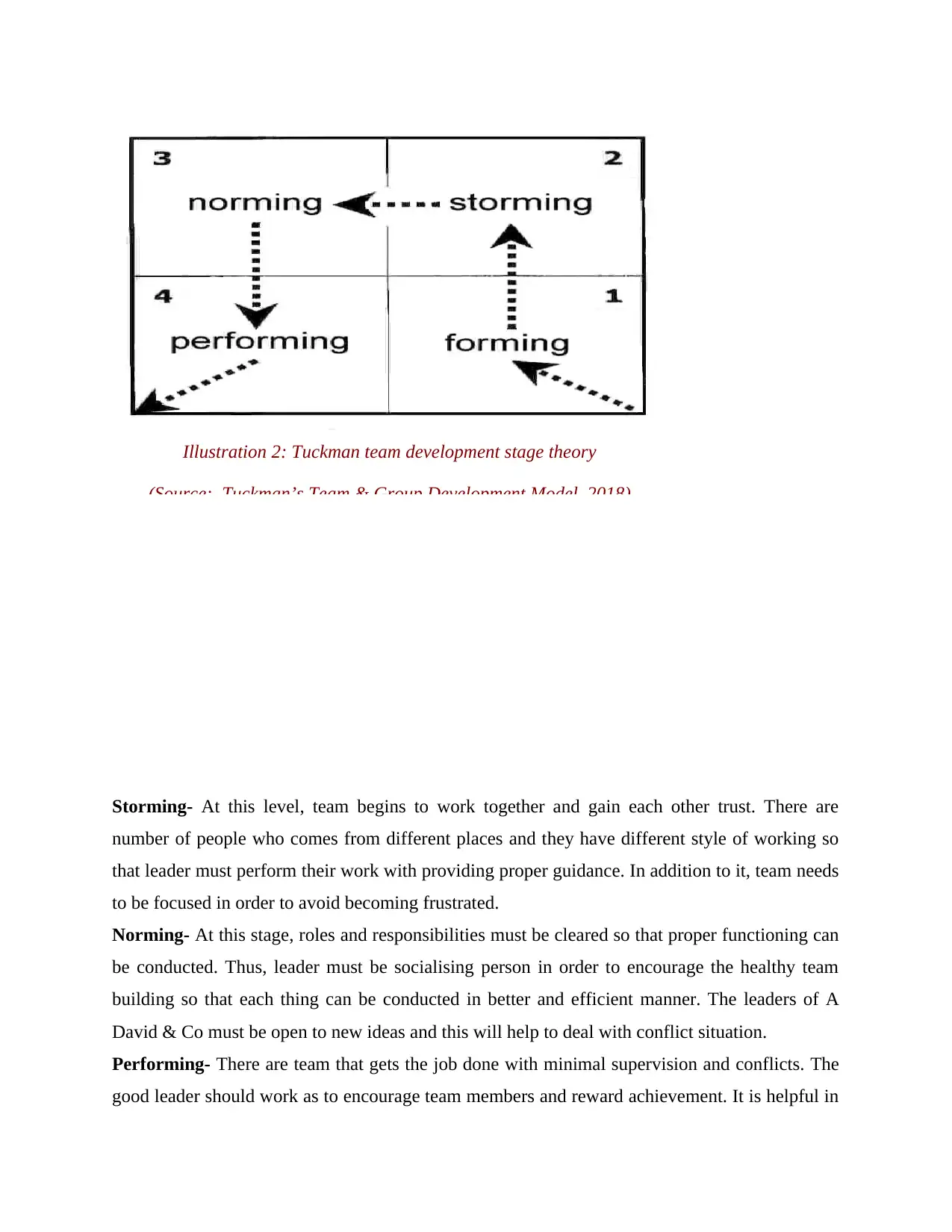
Illustration 2: Tuckman team development stage theory
(Source: Tuckman’s Team & Group Development Model, 2018)
Storming- At this level, team begins to work together and gain each other trust. There are
number of people who comes from different places and they have different style of working so
that leader must perform their work with providing proper guidance. In addition to it, team needs
to be focused in order to avoid becoming frustrated.
Norming- At this stage, roles and responsibilities must be cleared so that proper functioning can
be conducted. Thus, leader must be socialising person in order to encourage the healthy team
building so that each thing can be conducted in better and efficient manner. The leaders of A
David & Co must be open to new ideas and this will help to deal with conflict situation.
Performing- There are team that gets the job done with minimal supervision and conflicts. The
good leader should work as to encourage team members and reward achievement. It is helpful in
(Source: Tuckman’s Team & Group Development Model, 2018)
Storming- At this level, team begins to work together and gain each other trust. There are
number of people who comes from different places and they have different style of working so
that leader must perform their work with providing proper guidance. In addition to it, team needs
to be focused in order to avoid becoming frustrated.
Norming- At this stage, roles and responsibilities must be cleared so that proper functioning can
be conducted. Thus, leader must be socialising person in order to encourage the healthy team
building so that each thing can be conducted in better and efficient manner. The leaders of A
David & Co must be open to new ideas and this will help to deal with conflict situation.
Performing- There are team that gets the job done with minimal supervision and conflicts. The
good leader should work as to encourage team members and reward achievement. It is helpful in
⊘ This is a preview!⊘
Do you want full access?
Subscribe today to unlock all pages.

Trusted by 1+ million students worldwide
1 out of 16
Related Documents
Your All-in-One AI-Powered Toolkit for Academic Success.
+13062052269
info@desklib.com
Available 24*7 on WhatsApp / Email
![[object Object]](/_next/static/media/star-bottom.7253800d.svg)
Unlock your academic potential
Copyright © 2020–2025 A2Z Services. All Rights Reserved. Developed and managed by ZUCOL.





